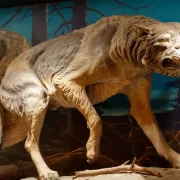
The eternal struggle between vampire and werewolf has dominated supernatural fiction for decades, but lurking in the shadows of this conflict is an often-overlooked predator: the dire wolf. These ancient, massive canines serve as more than mere background elements—they represent a primal force that both challenges and complements vampire mythology across various fantasy universes.
In “Underworld,” the stylized conflict between vampires and lycans draws inspiration from prehistoric reality. While the franchise’s werewolves aren’t explicitly called dire wolves, their imposing size and power mirror the real-world Canis dirus that once dominated North American landscapes. Standing nearly five feet tall with bone-crushing jaws, these prehistoric hunters embodied raw, untamed power—a stark contrast to the calculated, aristocratic nature of the Death Dealers. The franchise cleverly reimagines this natural opposition, suggesting that vampires’ refined deadliness evolved specifically to counter the overwhelming physical might of wolf-like creatures.
“The Vampire Diaries” universe takes a different approach, incorporating actual dire wolves into its extensive supernatural hierarchy. In the show’s mythology, dire wolves weren’t merely extinct canines but progenitors of the werewolf bloodlines. The ancient werewolf packs of the series trace their lineage directly to dire wolves blessed (or cursed) with transformation abilities. This connection elevates dire wolves from mere animals to creatures of inherent magical significance—the original shapeshifters whose blood still flows through modern werewolves.
The “Twilight” saga similarly amplifies its werewolves with dire wolf characteristics. The Quileute shapeshifters transform not into regular wolves but into creatures of prehistoric proportion, explicitly described as resembling dire wolves more than their modern descendants. This distinction serves a narrative purpose: only a predator of dire wolf proportions could credibly stand against vampire strength. Stephenie Meyer’s choice to invoke dire wolf imagery creates a more balanced supernatural ecosystem where cold ones and wolf warriors exist in tense equilibrium.
Some vampire fiction explores more complex relationships between these creatures. In Anne Rice’s later vampire chronicles, ancient blood-drinkers recall encounters with dire wolves during their earliest centuries—creatures that weren’t merely animals but possessed a preternatural awareness of the undead. These dire wolves could sense vampiric presence and would track them relentlessly, serving as natural checks against the spread of vampirism in primitive human societies.
Independent urban fantasy authors have expanded this concept further, creating worlds where dire wolves exist as a distinct third faction alongside vampires and werewolves. These reimagined dire wolves often possess their own unique abilities—immunity to vampire mind control, resistance to infection by either supernatural condition, or the ability to track magical beings across vast distances.
This three-way dynamic creates rich storytelling possibilities: dire wolves serving as neutral arbiters between warring supernatural factions, ancient vampires keeping dire wolf companions as both status symbols and protection against rival clans, or secretive dire wolf packs preserving the balance of supernatural power from the shadows.
The enduring appeal of dire wolves in vampire fiction stems from their perfect symbolic opposition: where vampires represent death, calculation, and unnatural longevity, dire wolves embody life, instinct, and primal vitality. They remind us that before humans crafted stories of elegant bloodsuckers, nature had already perfected the ultimate predator—one whose legacy continues to haunt our collective imagination across countless fantasy worlds.







